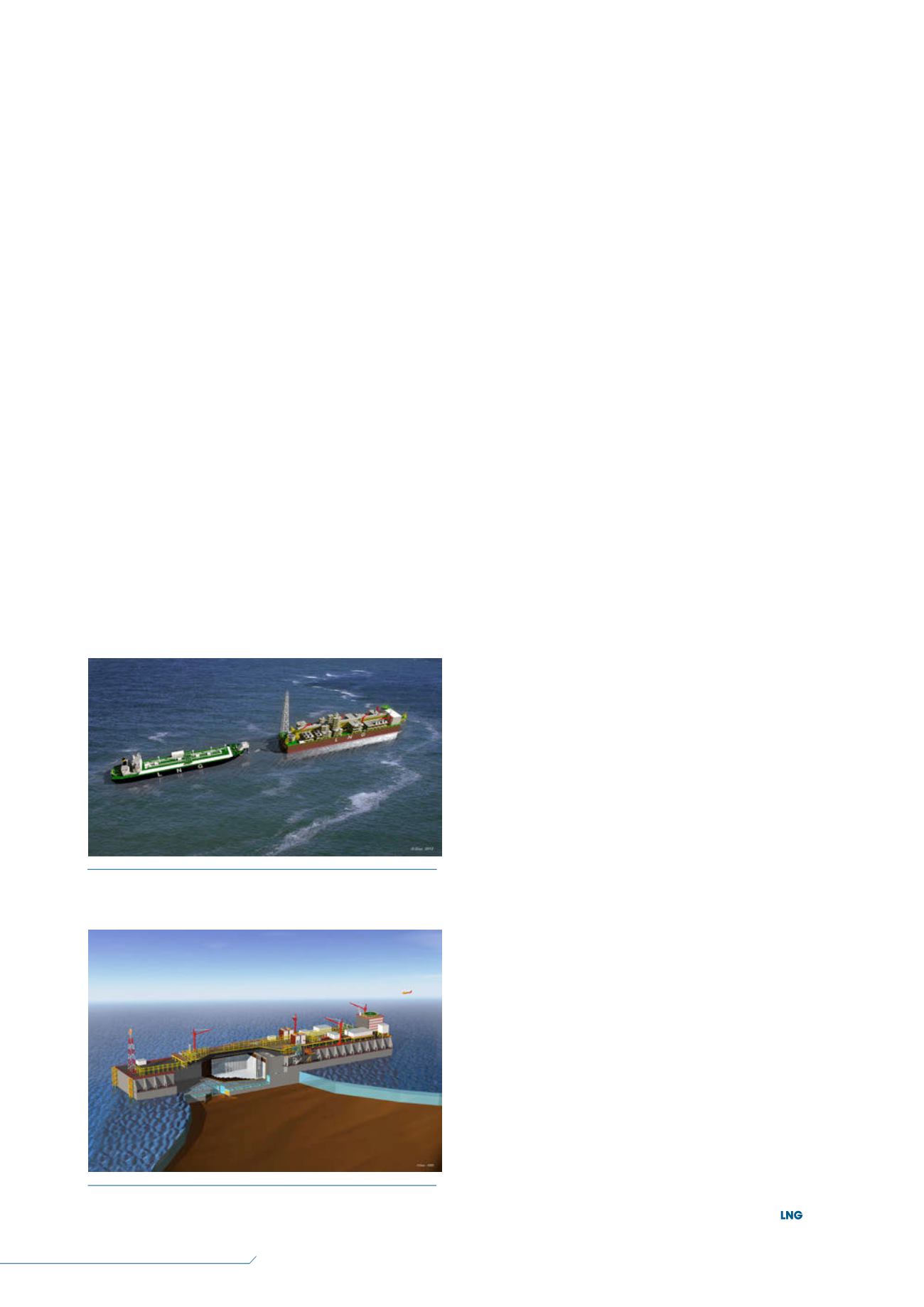
48
LNG
INDUSTRY
SEPTEMBER
2016
the expense of a lower efficiency compared with single
mixed refrigerant (SMR) and dual mixed refrigerant (DMR)
cycles, to help maximise their efficiency. Such cycles are
particularly relevant for small to medium scale FLNG units,
and may be implemented either on newbuilds or converted
LNG carriers. Here again, Moss Maritime is involved in
projects aiming at converting Moss LNG carriers into small
scale FLNG units thanks to the addition of sponsons on the
sides of the vessel to accommodate the topsides modules.
Another area for technology development is safety in
FLNG design. In this regard, one specific aspect of FLNG
operations is the large inventory of LNG and cryogenic fluids
required, which may pose a threat to the carbon steel
structures composing the hull and topsides modules. The
prevention and containment of cryogenic leaks is an area that
is seeing a great deal of work. Saipem has been developing
tools to improve the prediction of the impact of such leaks in
modules and on deck, so that leak protection systems can be
designed more efficiently.
Finally, one of the challenges for producing LNG offshore
in locations where environmental conditions can be harsh,
such as Brazil or Western Australia, is to be able to transfer
the LNG from the floating liquefaction unit to the carrier.
There are intrinsic limitations to the traditional side-by-side
offloading approach (where the LNG carrier is berthed
alongside the FLNG unit), such as the capability of tugs to
operate beyond certain wave heights, the tension induced in
the mooring lines when relative motions between the FLNG
unit and the LNG carrier are too large, and the size of the
loading arms required to deal with such large motions. Since
it is not typically possible for LNG to be safely transferred
from the FLNG unit to the LNG carrier beyond sea states with
significant wave heights of approximately 2 – 2.5 m, Saipem
developed a tandem offloading system where the LNG
carrier is aligned with the FLNG at a distance of
approximately 100 m. The LNG is transferred through a
floating cryogenic flexible pipe developed by Trelleborg in
partnership with Total and Saipem. This configuration
increases the safety of the transfer operation due to the
much larger separation distance and permits unloading in
harsh sea states, making FLNG a viable solution for almost
any location in the world.
Concrete gravity-based
structures and floating
production units
The gravity-based structure (GBS) approach was mostly
promoted in the late 1990s and early 2000s for regasification
plants, in response to a fast-growing LNG market and to the
challenges of obtaining permits for onshore regasification
plants. However, the concept of a concrete GBS can
be just as relevant for liquefaction facilities. The use of
concrete is particularly suited to LNG applications thanks
both to its strong resistance to cryogenic spillage, and
to the advantages provided by a flat wide deck that can
accommodate very heavy topsides.
The LNG GBS is usually designed for shallow waters
(nearshore applications). Saipem has developed several
design options for such facilities: the GBS can be designed as
a long rectangular breakwater for exposed environmental
conditions, or optimised in a more compact prismatic or
cylindrical shape to minimise concrete quantities, depending
on project-specific requirements. The GBS may also offer
significant benefits in terms of local content if the fabrication
of the concrete hull can take place in the final installation
country using a pre-existing or new dedicated graving-dock.
Although concrete hulls have been mostly considered for
GBS applications, floating concrete hulls have also been
considered by the industry over the past few years. A
concrete floating production unit (FPU) barge was built for
the N’Kossa project (Total) by Saipem in 1994, but this was
for oil production at the time. The competitiveness of a
complete FLNG unit built with a concrete hull compared to a
steel hull FLNG may be questioned, but a scheme with an
LNG concrete FPU carrying liquefaction topsides combined
with a converted LNG carrier floating storage and offloading
(FSO) unit could benefit from the significantly lower cost of
the hulls and become an interesting option for some sites
and countries.
Conclusion
Over the past 20 years, offshore LNG has become a reality
thanks to the adaptation of LNG technologies to offshore
constraints and the development of specific enabling
technologies that have now reached maturity. Saipem has
played a major part in the various developments described
in this article through a number of collaborations with major
oil and gas companies and key suppliers. Today, the new
challenge for the LNG industry is to make those technologies
viable in the context of a low oil price environment.
Figure 4.
Breakwater-shaped regasification gravity-based
structure (GBS) with sectional view.
Figure 3.
LNG tandem offloading configuration with floating
hoses.


